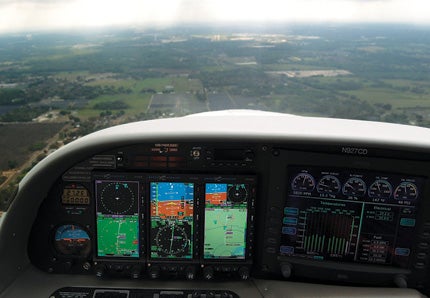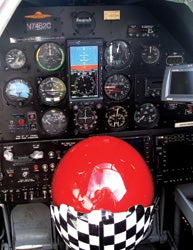Aspen Glow
With Aspen Avionics’ multi-unit flight display, you can go all-glass on a budget
 The last of the AeroShell Aerobatic Team T-6s lets out a sonorous belch as its propeller spins to a stop, and I walk up to its hefty wing to meet Gene McNeely, slot pilot for the team. He's showing me the latest, seemingly incongruous addition to the team's T-6s. There, in the front 'pit, is an Aspen Avionics Evolution EFD1000 PFD. Though such a seemingly delicate navigational instrument appears out of place on this snorting aerobatic airplane from WWII, I quickly find out that it has become an indispensable part of the team.
The last of the AeroShell Aerobatic Team T-6s lets out a sonorous belch as its propeller spins to a stop, and I walk up to its hefty wing to meet Gene McNeely, slot pilot for the team. He's showing me the latest, seemingly incongruous addition to the team's T-6s. There, in the front 'pit, is an Aspen Avionics Evolution EFD1000 PFD. Though such a seemingly delicate navigational instrument appears out of place on this snorting aerobatic airplane from WWII, I quickly find out that it has become an indispensable part of the team.
"I fly to 25 air shows a year and log about 250 hours on average each year. If I'm scheduled to fly an air show, I have to be there," says McNeely. "We file IFR, and the Aspen has made IFR flying a dream. It has changed how we fly." McNeely and the rest of the team use the unit for en route navigation and instrument approaches. "The flight director of the Aspen unit is connected to our Garmin MX20, our MX80 and our S-Tec autopilot," adds McNeely.
Aspen Avionics has led the retrofit revolution since it began turning out innovative and affordable general aviation cockpit displays from its Albuquerque location in 2005. The company's flagship product is its Evolution glass cockpit system. For under $6,000, a pilot can replace the "six-pack" flight instruments with a slide-in, modular PFD that increases situational awareness to an amazing degree. Simple software upgrades add new features to the unit, making it future-proof, while the capability of the Evolution series is nothing short of phenomenal.
But the real news is the way Aspen has expanded its display systems to work together in multiunit clusters to provide all the capability of large glass cockpit systems in a more compact footprint. In fact, the new Evolution multiunit displays---featuring the recently certified EFD500 MFD and EFD1000 MFD---offer even more features than some of the "big-box" competitors, all in a more affordable and easily upgradable product. It's all about modularity.
By combining different slide-in units, a full-spectrum total glass cockpit is within the reach of just about any GA airplane. The units fit into standard three-inch holes in the instrument panel and are designed to work with existing GPS units, autopilots and flight directors. Through the modular units, the system's basic functionality can be enhanced with features like terrain information, traffic, weather, full IFR capability and a lot more. A convenient and well-placed data port on the front of the unit makes software upgrades a no-headache affair.
Aspen's Evolution 2500 package is an example of the company's new multi-unit retrofit approach. The 2500 "system" couples three Evolution units to put a huge display area in front of the pilot, with just about anything imaginable only a few button strokes away. It combines the 1000 Pro PFD (which adds full IFR capability to the basic EFD1000 PFD), the EFD1000 MFD and the 500 MFD to deliver what Aspen calls its "total glass cockpit solution."
Scott Smith is a regional sales manager for Aspen Avionics and flies his 2002 Cirrus SR22 for both work and fun. He has a "three-display" Evolution setup in his immaculate airplane, and I was fortunate to meet him for some flying fun, also an opportunity to see how the triple-unit combination works in real life. In fact, the gray and gloomy Florida day would be a perfect stage to see what the Aspen system could do.
"One of the main things about this unit," Smith said as we settled into the cockpit, "is that your whole scan is right there. It's all in front of you." Smith added that it eases the workload during IFR operations because it shows everything the pilot needs. "All the information for the approach is on one display," he said. I noticed that Smith configured his three-unit display slightly different than the Evolution 2500 package. His Cirrus had two EFD1000s (an EFD1000 Pro MFD and EFD1000 MFD) and a single EFD500 MFD. Pilots can mix and match, as they prefer.
During run-up, Smith explained some of the other big draws of the multidisplay idea. "You get dual everything," he added. With a multidisplay setup, pilots get dual independent AHRS, air-data computers, compass systems and HSIs. Aspen also has an exclusive feature it calls DuoSafe redundancy: If your PFD fails, you simply press the "REV" (revisionary) button on the EFD1000 MFD, and it instantly becomes your PFD and still part of your instrument scan. The feature is designed to eliminate confusion during a unit failure and to make the situation easier to handle.
Aspen's features are wholly impressive. The basics include airspeed and altitude tapes, an altitude alerter (including a separate alert for approach minimums), an electronic, two-bearing pointer HSI, moving map with curved flight paths, GPS steering with compatible navigators (like Garmin), and a superbright, very readable six-inch, 140-pixel-per-inch LCD screen. Watching the display on takeoff, I found it unusually crisp and easy to read, though I have to admit I found some of the symbols very small and a tad challenging on my not-20/20-anymore eyes. And even when the ambient light changed to sun rays, it didn't seem to affect the readability of the displays.
But I wanted to get to the heart of what makes Aspen Avionics special. As we climbed into the cloud layer, I asked Smith---who has nearly 1,000 hours of experience with Aspen displays---what his favorite feature is. "That's easy," he smiled. "The winds-aloft feature and the slaved directional gyro." Smith explained that the unit's built-in air-data computer calculates wind speed and direction in real time, and shows an arrow to help the pilot visualize it. The pilot can set the integrated heading bug and follow the wind-corrected course, all the while seeing true airspeed calculated in real time. The slaved directional gyro means you'll never have to set your DG to the "whiskey" (magnetic) compass again.
Aspen has really hit the ball out of the park with some of its newest goodies. Synthetic vision will be an optional add-on to the EFD1000 Pro in Q1 2011; it renders a real-time 3D view of terrain, traffic and other hazards. Even at night, synthetic vision renders the scene as if it were daylight, making situational awareness a no-brainer.
Evolution Hazard Awareness displays flight hazards by combining data link weather (via XM aviation products), traffic, terrain and Stormscope lightning, and overlaying it on your primary moving-map navigational display. If your autopilot supports a flight director, the 1000 Pro will give you a single-cue flight director that makes hand flying easier. Charts and georeferenced airport maps can be loaded onto the new MFDs. Aspen also is adding a new engine display module to its MFDs; it'll be available by the end of this year. All units have a built-in battery backup and emergency GPS.
The skies above this part of Florida are swarmed with traffic of all types, and Smith is showing me all the capabilities of the Aspen units while looking outside, handling ATC and avoiding traffic through the built-in traffic displays. Frankly, it's a ton of information, though Smith's practiced fingers make it all look easy. "It doesn't take long to get very familiar with all this," Smith assures me. As he sets up for the approach, it's easy to see the value of the three-display setup.
In approach mode, I see how both lateral and vertical deviation indicators are overlaid on the attitude director indicator on the top half of the PFD. Approach minimums are displayed right in front of the pilot, so your scan stays tight. The PFD is coupled to Smith's autopilot, so it flies the entire approach, including anticipating turns through its GPS steering coupled with a Garmin GNS 430W. In fact, the Aspen PFDs can be coupled to most autopilots and flight directors. "This can interface with just about anything with a heading bug," adds Smith.
Pilots can configure these multiunits to show just about anything available. The MFDs, for example, can be split three ways. A pilot could put terrain and traffic on one MFD while viewing weather on another, and then set the PFD to display only a minimum of information. "They can be configured one way for the en route segment, and another way for the approach," says Smith. The entire visual aspect can be based on how the pilot likes it." The user interface consists of buttons along the right side of the unit, and two knobs along the bottom.
I have the advantage that our backseat passenger this morning is Kevin Williams, Aspen's field service engineer. I ask him about the reliability of the units as well as the support. "There are no moving parts in these units so they're extremely reliable," says Williams. "We've done about 2,500 installations in light aircraft." Williams adds that the front data port is a huge plus for field upgrades and support. "We can upgrade a customer to all kinds of new capabilities without ever touching the hardware," he says.
Aspen Avionics is unique because of the affordability and the modularity of its products. The units slide into existing instrument panels and work with existing systems, and installation is easier and costs less than a traditional glass-panel retrofit. Pricing for the Evolution series ranges from the aforementioned $5,995 for the EFD1000 Pilot to $22,895 for the 2500-series, three-display, full-IFR system. All Aspen components can be purchased separately, so pilots can "build" systems as their budgets allow.
Back with the AeroShell T-6s, McNeely and team member and right wingman Mark Henley talk about their EFD1000s. "You'd think the thing is broken, it tracks so well," laughs Henley. They both agree that the addition of the Aspen Evolution unit allows them to travel to more destinations in all kinds of weather. "The team uses the Aspen all the time," Henley adds. "Heck, we don't even turn it off during the air show." Visit www.aspenavionics.com.
| Aspen Goes Aerobatic |
|
|

Subscribe to Our Newsletter
Get the latest Plane & Pilot Magazine stories delivered directly to your inbox

 The EFD1000 in the AeroShell Team T-6 Texans is becoming a common sight in other aerobatic cockpits. In addition to the AeroShell Team's T-6 airplanes, the Aspen EFD is installed in Jim Pietz's aerobatic Beechcraft F33C Bonanza. Extra Aircraft has certified the Aspen EFD1000 for its EA-300/L, LP and LC models, and American Champion offers its Citabria with the EFD1000 as an option. Also, on the air show circuit, Greg Poe has installed the EFD1000 in his "Fagen" A36 Bonanza, and, according to Aspen, the units have been installed in P-51s and even L-39 jets.
The EFD1000 in the AeroShell Team T-6 Texans is becoming a common sight in other aerobatic cockpits. In addition to the AeroShell Team's T-6 airplanes, the Aspen EFD is installed in Jim Pietz's aerobatic Beechcraft F33C Bonanza. Extra Aircraft has certified the Aspen EFD1000 for its EA-300/L, LP and LC models, and American Champion offers its Citabria with the EFD1000 as an option. Also, on the air show circuit, Greg Poe has installed the EFD1000 in his "Fagen" A36 Bonanza, and, according to Aspen, the units have been installed in P-51s and even L-39 jets. 



